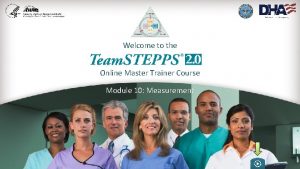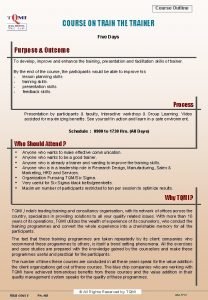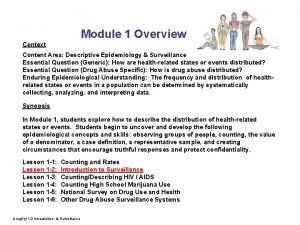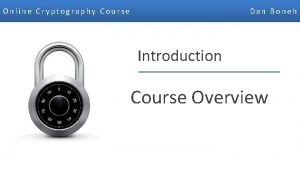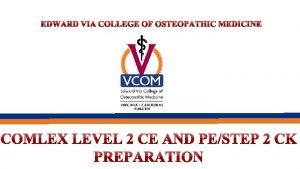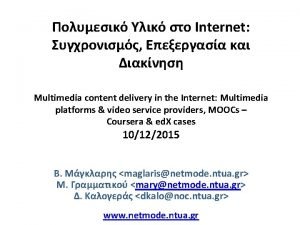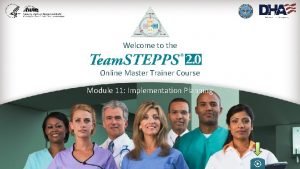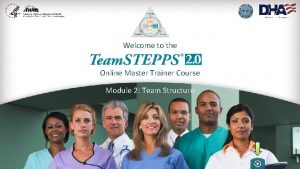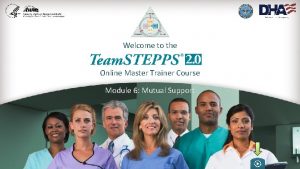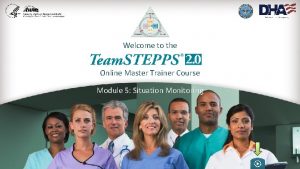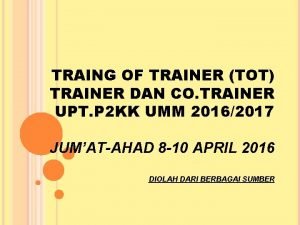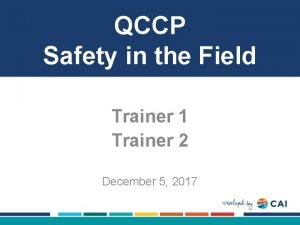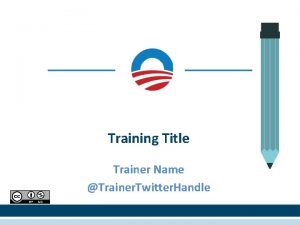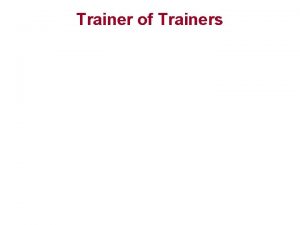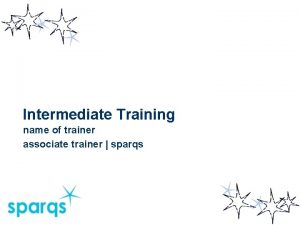Welcome to the Online Master Trainer Course Module







































- Slides: 39

Welcome to the Online Master Trainer Course Module 3: Communication

How This Online Course Works This module will walk you through the Team. STEPPS content just as you will present it when you train your colleagues and staff It teaches you all the concepts that comprise the Team. STEPPS initiative While also teaching you to teach Team. STEPPS to your colleagues Use the navigation buttons in the lower right to work through the online modules Select here to move back to the previous slide Module 3: Communication Select here to move to the next slide 2 of 39

The Materials You Will Use When you deliver your training you will use these materials: • Instructor Manual – Course Management Guide – Instructor guides – Course slides – Measurement tools • Customizable materials • Videos Module 3: Communication Select here to review materials on the Team. STEPPS website 3 of 39

Please Print the Instructor Guide To best use this online module, please print the Module 3 Instructor Guide, located here. You may also want to print the Team. STEPPS Pocket Guide Then we will proceed to work through the slides you will use to train – just as if you are delivering this module at your facility. Module 3: Communication 4 of 39

Cover Slide: Prepare to Train As you teach this module, you will present information about communication Convey the importance of communication and how the use of effective information exchange strategies can improve patient safety Communications Tools on page 9 of the Pocket Guide See page 3 in the Instructor Guide Module 3: Communication 5 of 39

Slide 2: Objectives Use slide two to preview what will be covered in this module See page 5 in the Instructor Guide for details on how to facilitate this slide Module 3: Communication 6 of 39

Slide 3: Introduce Communication Using slide 3, you will provide an overview of Communication is the lifeline of a wellfunctioning team We will discuss the standards of effective communication Module 3: Communication 7 of 39

Importance of Communication (Slide 4) Joint Commission data continues to demonstrate the importance of communication in patient safety: • 1995 - 2005: Ineffective communication identified as root cause for nearly 66 percent of all reported sentinel events * • 2010 - 2012: Ineffective communication among top 13 root causes of sentinel events reported ** See Instructor Guide, pages 7 -9 * (JC Root Causes and Percentages for Sentinel Events (All Categories) January 1995−December 2005) ** (JC Sentinel Event Data (Root Causes by Event Type) 2004 -2012) Select Here for Joint Commission Data Note: When presenting, update this slide annually by going to the Joint Commission Web site and locating the updated data. Module 3: Communication 8 of 39

Communication is… The process by which information is exchanged between individuals, departments, or organizations The lifeline of the core team Effective when it permeates every aspect of an organization Consider: Who? How? Two modes: • Verbal • Nonverbal Module 3: Communication Assumptions Fatigue Distractions HIPAA See Instructor Guide, pages 10 -11 9 of 39

Nonverbal Communication Written Communication – adheres to standards we will discuss Body Language • In face-to-face communication: • Words: 7% of meaning • Tone of voice: 38% • Body language: 55% Visual Cues • Such as color coding See pages 10 -11 in the Instructor Guide Module 3: Communication 10 of 39

Standards of Effective Communication Complete • Communicate all relevant information Clear • Convey information that is plainly understood Brief • Communicate the information concisely Timely • Offer and request information in an appropriate timeframe • Verify authenticity • Validate or acknowledge information Module 3: Communication Clear Brief Timely See Instructor Guide, page 12 11 of 39

Communication Challenges Language barriers Distractions Physical proximity Personalities Workload Varying communication styles Conflict Lack of information verification Shift change Module 3: Communication See Instructor Guide, pages 14 -15 12 of 39

Communication Challenges Scenario: An 89 -year-old female with a history of chest pain Many tests are being run Family requests code status be changed to DNR Night shift documents DNR in the progress note, but does not flag the patient’s chart, relay during shift change, or notify the attending physician • Morning shift does not read the night shift’s notes • • Where might miscommunication occur in this situation? What are the possible outcomes? Module 3: Communication 13 of 39

Scenario Questions Discussion Miscommunication in the scenario: • Night shift failed to flag the patient chart • Night shift failed to relay the information during shift report • Doctor was notified The possible outcomes: • The day shift resuscitated the patient • Patient underwent additional testing/procedures Miscommunication could be avoided if: • Night shift took more time to discuss the patient during the shift change • Proper documentation occurs • Doctor is notified Module 3: Communication 14 of 39

Slide 9: Information Exchange Strategies We will review four strategies to improve communication: • SBAR • Call-Outs • Check-Backs • Handoffs See page 9 of the Team. STEPPS Pocket Guide for additional information See Instructor Guide, page 16 Module 3: Communication 15 of 39

SBAR Provides… (Slide 10) SBAR provides a standardized framework for communication In conversation, consider: • Situation • What is happening with the patient? • Background • What is the clinical background? • Assessment • What do I think the problem is? • Recommendation • What would I recommend? Module 3: Communication See Instructor Guide, page 17 16 of 39

Using SBAR with Patients SBAR can also be used by patients Share information on situation, background Ask the care team about their care See page 17 of the Instructor Guide Visit DOD’s Engaging Patients through TEAM UP website Module 3: Communication 17 of 39

Slide 11: SBAR Video Review the SBAR technique See page 18 in the Instructor Guide for details on how to use this video After you watch the video, return to this window to continue the module Select the image to launch a web browser where you can watch the video Module 3: Communication 18 of 39

Video Discussion Lead a discussion of this question: How did the SBAR technique improve communication between the nurse and physician? Point out: • Identified herself and reason for call • Provided background of DVT diagnosis • Assessment of the patient • Recommendation for additional labs Module 3: Communication 19 of 39

Slide 12: SBAR Exercise See page 19 in the Instructor Guide Take a few minutes to write out your own SBAR example Questions? Use the “FAQ” button below Module 3: Communication 20 of 39

Call-Out Is… (Slide 13) A strategy used to communicate important or critical information • It informs all team members simultaneously during emergency situations • It helps team members anticipate next steps See Instructor Guide, page 20 Module 3: Communication 21 of 39

Call Out Video After viewing the video, discuss this question: How did the call-outs made by the nurse and intern aid the team during this emergent Labor and Delivery event? Select the image to launch a web browser where you can watch the video Module 3: Communication 22 of 39

Call-Out Video Discussion How did the call-outs aid the team? • Team members verbally confirmed critical information • The team was anticipating future actions • Information was directed by name to Dr. Dean for response and feedback Module 3: Communication 23 of 39

Check-Back Is… (Slide 14) See Instructor Guide, page 21 Module 3: Communication 24 of 39

Check-Back Video After viewing the video, discuss these questions: • Who was the sender? Receiver? • How did they “close the loop” ? • What errors were avoided? Select the image to launch a web browser where you can watch the video Module 3: Communication 25 of 39

Check-Back Video Discussion Share these observations: • Pharmacist was Sender and Resident was Receiver • Closed the loop with “Correct. ” • They avoided errors because: • The Pharmacist did not rely on memory • The Resident wrote the exact dosing instructions Module 3: Communication 26 of 39

Handoff is… (Slide 15) The transfer of information during transitions in care across the continuum Includes an opportunity to ask questions, clarify, and confirm See page 22 in the Instructor Guide for more information Joint Commission's Tool to Tackle Miscommunication Among Caregivers Module 3: Communication 27 of 39

A Handoff Consists of… (Slide 16) Transfer of responsibility and accountability Clarity of information Verbal communication of information Acknowledgment by receiver Opportunity to review See Instructor Guide, page 23 Module 3: Communication 28 of 39

Handoffs Transfer… The degree of certainty regarding a patient The patient’s response to treatment Recent changes in condition and circumstances The plan of care, including contingencies Both authority and responsibility are transferred in a handoff See Instructor Guide, page 23 Module 3: Communication 29 of 39

Handoff Video While watching the video, ask these questions: • What went well in the handoff in this video? • Was there anything about the handoff that could have been improved? Select the image to launch a web browser where you can watch the video Module 3: Communication 30 of 39

Handoff Video Discussion What went well: • Continuity of care was maintained • Pain management was discussed • Medications were reviewed • Plan of care was discussed • High threats were announced • Expectations and responsibilities were completed Face-to-face or in-person handoffs could have improved the handoff Module 3: Communication 31 of 39

I PASS the BATON (Slide 17) Introduction: Introduce yourself and your role/job (include patient) THE Patient: Background: Comorbidities, previous episodes, current medications, and family history Identifiers, age, sex, location Assessment: Present chief complaint, vital signs, symptoms, and diagnosis Situation: Safety: Current status/circumstances, including code status, level of uncertainty, recent changes, and response to treatment Critical lab values/reports, socioeconomic factors, allergies, and alerts (falls, isolation, etc. ) Module 3: Communication Actions: What actions were taken or are required? Provide brief rationale Timing: Level of urgency and explicit timing and prioritization of actions Ownership: Who is responsible (nurse/doctor/team)? Include patient/family responsibilities Next: What will happen next? Anticipated changes? What is the plan? Are there contingency plans? 32 of 39

I PASS the BATON Video As you watch this video, consider this question: How was I PASS the BATON used in this physician-to-physician example? Select the image to launch a web browser where you can watch the video Module 3: Communication 33 of 39

I PASS the BATON Video Discussion I PASS the BATON was demonstrated in: • Physician shift change (showing responsibility) • Discussed the evolving patient condition • Sharing of information for better decision making See Instructor Guide, page 26 Module 3: Communication 34 of 39

Other Handoff Tools (Slide 18) ANTICipate • Administrative Data; New clinical information; Tasks to be performed; Illness severity; Contingency plans for changes I PASS • Illness severity; Patient Summary; Action list for the new team; Situation awareness and contingency plans; Synthesis and “read back” of the information SHARQ • Situation; History; Assessment; Recommendations/Result; Questions Module 3: Communication See page 27 in the Instructors Guide for additional handoff tools 35 of 39

Tools & Strategies Summary BARRIERS • Inconsistency in Team Membership • Lack of Time • Lack of Information Sharing • Hierarchy • Defensiveness • Conventional Thinking • Complacency • Varying Communication Styles • Conflict • Lack of Coordination and Follow-up With Coworkers • Distractions • Fatigue • Workload • Misinterpretation of Cues • Lack of Role Clarity Module 3: Communication TOOLS and STRATEGIES Communication • • SBAR Call-Out Check-Back Handoff OUTCOMES n Shared Mental Model n Adaptability n Team Orientation n Mutual Trust n Team Performance n Patient Safety!! 36 of 39

Slide 20: Applying Team. STEPPS Exercise Close Module 3 by answering these questions: • Is your teamwork issue related to communication? • If yes, what is the communication issue? • Which Team. STEPPS tools and/or strategies might you consider implementing to address the issue? Select here to download and print the Team. STEPPS Implementation Worksheet and answer the question. Module 3: Communication 37 of 39

Module 3 Summary In this module you learned to: • Describe how communication affects team processes and outcomes • Define effective communication • Identify communication challenges • Identify Team. STEPPS tools and strategies that can improve a team’s communication Module 3: Communication 38 of 39

Module 3 Conclusion This concludes Module 3 of the Team. STEPPS 2. 0 Online Master Trainer Course Go to Module 4 Module 3: Communication 39 of 39
 Teamstepps master trainer
Teamstepps master trainer Master trainer 45
Master trainer 45 Train the trainer objectives
Train the trainer objectives Train the trainer training program outline
Train the trainer training program outline C device module module 1
C device module module 1 Front line leadership definition
Front line leadership definition Course module sample
Course module sample Wise men three clever are we
Wise men three clever are we Welcome my students
Welcome my students Cut brick lengthwise
Cut brick lengthwise Course title and course number
Course title and course number Course interne course externe
Course interne course externe Welcome to city guesser
Welcome to city guesser Welcome access online
Welcome access online Welcome to my online class
Welcome to my online class Dan boneh cryptography 2
Dan boneh cryptography 2 Supplemental online coursework
Supplemental online coursework Ipac core competencies administrative controls answers
Ipac core competencies administrative controls answers Online cryptography course
Online cryptography course Njrotc instructor vacancies
Njrotc instructor vacancies Ptit safe driving and awareness course
Ptit safe driving and awareness course Comlex level 2 ce prep course
Comlex level 2 ce prep course Medical english online course
Medical english online course Fmcsa north american standard level i course online
Fmcsa north american standard level i course online Jrotc marksmanship instructor course online
Jrotc marksmanship instructor course online Massive open online course
Massive open online course Chandler online academy
Chandler online academy American beauty academy
American beauty academy Hình ảnh bộ gõ cơ thể búng tay
Hình ảnh bộ gõ cơ thể búng tay Slidetodoc
Slidetodoc Bổ thể
Bổ thể Tỉ lệ cơ thể trẻ em
Tỉ lệ cơ thể trẻ em Voi kéo gỗ như thế nào
Voi kéo gỗ như thế nào Tư thế worms-breton
Tư thế worms-breton Bài hát chúa yêu trần thế alleluia
Bài hát chúa yêu trần thế alleluia Các môn thể thao bắt đầu bằng từ đua
Các môn thể thao bắt đầu bằng từ đua Thế nào là hệ số cao nhất
Thế nào là hệ số cao nhất Các châu lục và đại dương trên thế giới
Các châu lục và đại dương trên thế giới Công của trọng lực
Công của trọng lực Trời xanh đây là của chúng ta thể thơ
Trời xanh đây là của chúng ta thể thơ
